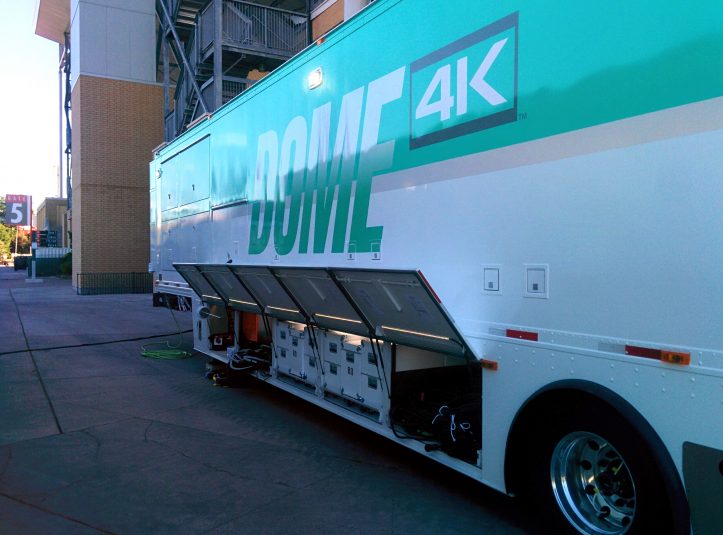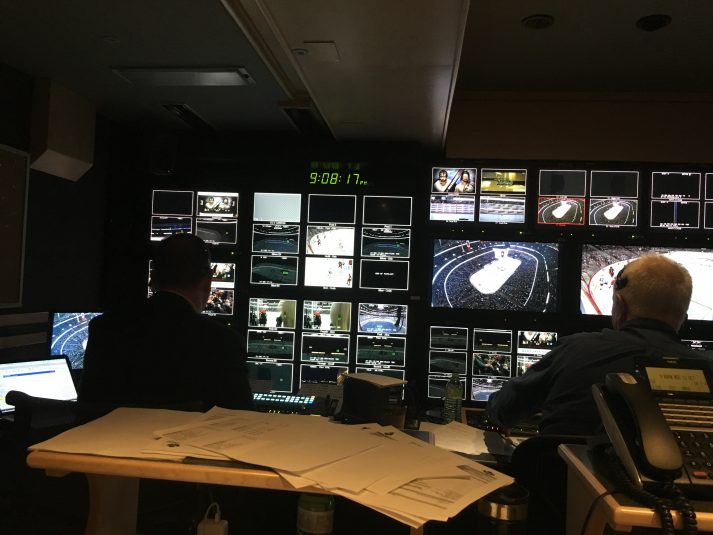Dome Productions Expands Its Commitment to 4K/UHD in Canada
The company's latest 4K mobile production unit, Pioneer, is on the road
Story Highlights
Dome Productions continues to serve Canada’s thriving 4K/UHD sports market with its latest mobile production unit, Pioneer. The 4K/UHD-capable truck has had plenty to keep it busy since hitting the road in July for TSN’s coverage of a Toronto FC match at BMO Field; Pioneer has also covered the Canadian Football League and a variety of sports and entertainment productions and will continue to cover the Toronto Raptors as well as a number of NHL games throughout the 2016-17 season.
The most recent addition to Dome Productions’ 4K arsenal, Pioneer gives the Toronto-based mobile-production provider additional flexibility to service the 4K-production needs of its television partners, Rogers Media and Bell Media.
Pioneer features a Grass Valley 2M/E K-Frame switcher, Evertz EQX router with 135×112 UHD video capacity, four three-channel EVS UHD LSM XT3 replay servers, ChyronHego Mosaic graphics engine, and Calrec Artemis Beam digital console with BlueFin2. The truck is wired for 10 Sony HDC-4300 cameras and carries a variety of Fujinon 4K lenses. The truck services HD productions in addition to its 4K slate; the on-board technology and cameras simply run in a different configuration.
“When we were asked to come up with the solution to produce 4K, we realized that 4K has to be a single truck unit. We continue to do the side-by-side, [and we had] to figure that out,” says Mary Ellen Carlyle, SVP/GM, Dome Productions. “The team figured that out, and, on July 1, they put out a single solution. One [television partner] is taking a 4K feed directly and downconverting to HD at their plant. The other one’s downconverting it at the truck, and we’re spitting out 4K and HD. Our challenge was to give them the tools that they need to produce in the way that they always had produced, without losing the integrity of the HD show.”
Dome Productions’ first foray into 4K production occurred in early 2016, when both Rogers and Bell announced that they would deliver NBA and NHL games live in 4K to their subscribers. The company’s first 4K show — TSN’s coverage of a Toronto Raptors game at Air Canada Centre — was produced in side-by-side mobile units dedicated to powering the 4K and HD productions, respectively.
The side-by-side model, however, was always intended to be a stop-gap solution until one of Dome Productions’ existing trucks, Trillium, could be configured to handle 4K. Because Rogers announced its 4K plans in October, Dome had only four months before Sportsnet’s scheduled 4K broadcast of the Maple Leafs on Jan. 23.
“We couldn’t produce a Pioneer in four months. There’s no physical way we could have done that, even if we found somebody that had a trailer,” explains Carlyle. “Trillium was a stepping stone to get there. [Director of Engineering] Mike [Johnson] and his group put together a layer of 4K on top of the HD — basically, as a B unit — so they can operate in HD and, if it needs to be 4K, all the guts of the 4K are in the B unit. But that’s not where we wanted to stay.”
Now that Pioneer is on the road as a true standalone 4K production unit, Dome Productions is hoping to transform Trillium from a temporary 4K option in two trailers into a permanent 4K solution that can fit in one. The reconfigured Trillium, which will make use of the original Trillium’s Grass Valley K-Frame production switcher and 10 Sony HDC-4300 cameras, is scheduled to roll out some time in 2017.
“We have two partners that adopted 4K strategies, and both wanted to enter the 4K market. We couldn’t say the truck’s not available,” says Johnson. “Now, with two trucks, they could both be doing 4K on a given night at the same time.”


